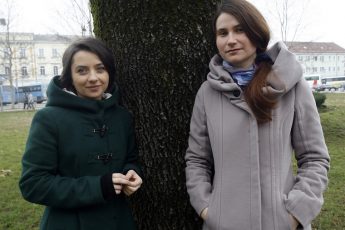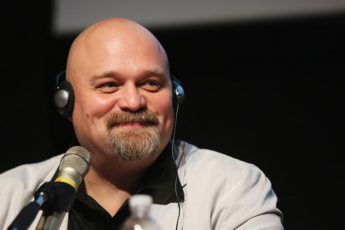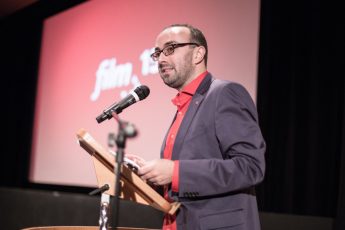
Magdalena Shterianova interviewed Boris Yukhananov on the occasion of our special issue on Soviet Parallel Cinema. Film and theater director, theoretician, and teacher, Yukhananov is a key figure of the 1980s underground film movement in the Soviet Union. He speaks about the aesthetics of and theory behind his art, the history of the Parallel Cinema movement, and contemporary culture.
You are considered one of the main representatives of Soviet Parallel Cinema. However, you perceive your video novels as video art, not cinema. Where would you draw the line between video and cinema?
Let me start from the beginning. Parallel Cinema emerged in Russia in the mid-80s, when the Aleynikov brothers assembled a motley company of film and video directors and started publishing the samizdat magazine Cine Fantom. I met them just at that time, when everyone was waiting for some “bright future” – nothing but illusions. Yet under the influence of these illusions some wonderful collective creativity was born. By the time we met, I had made one 35mm short film at VGIK. And then I got hold of a video camera and an abyss of possibilities opened up for me. For several years, I wouldn’t be separated from it. I then joined Cine Fantom’s editorial board. I wrote theoretical articles about video art, and created the video novel The Mad Prince.1 Later on, I continued to work on both cinematographic and video projects.
The difference between video and other media is that video is like a big metaphor. The video camera is a kind of instrument that simultaneously records sound, captures the flow of reality, and digitizes it. The camera perceives reality and transforms it into the form of an image all at once, creating a constant continuity of action. The difference between cinema and video is defined by the very first moment when you press the button of your video camera and suddenly eternity unfolds. I describe this difference with the help of two categories, the model (model’) and the layout (maket). Cinematography models reality in order to make a film. It does so by using a variety of tools: scripting, fixing the future of a film a priori, lighting, doing rehearsals, approaching the episode, separating the sound from the image, etc., etc. I would put all this under the term layout. Video, in contrast, is more of a model, it’s a kind of infusion of reality to gradually bring it into the model of an ongoing process. In this sense, reality and its performative origin become incredibly intense.
The video camera allows the artistic process to become a more authentic discovery of reality. Ironically, video is a more archaic tool than cinematography. This can also be explained by the example of text and speech. Video belongs to the sphere of speech. Speech is something unfinished that strives for development. Video has a similar potential for development. In my texts, there is the concept of matrix [the totality of uncut video material] which is the limit from which the process of video speech unfolds. From there, the matrix sends us on the adventures of editing, the creation of variations and so on. All the other important features of the creative process that are related to the actor, the script narrative, light, space or time, all of these incredibly mutate in this transition from film to video and back. It’s also very interesting to play with the very act of this transition from one art form to another. In the chapters of my video novel, I play with these transitions in my own way.
Is it possible to say that your concept of fatal editing2 can also be used in cinematography?
It’s not possible because that’s a technical feature of a 8mm video camera. If such a feature is present in other cameras, it’s possible. I create a matrix over the course of a few days or even months. This matrix is a continuous stream, a kind of instrumented reality. And then I begin to turn against myself very harshly. It’s as if I had to cross myself out. With the same camera that contains the material, drawing on my own life, I begin editing reality that was created during the process of shooting. To complete the film, I undergo a special regime of participation. I remember what I have filmed, and when I see a new piece of reality in front of me, I discard the previous one which was recorded earlier. This is not a palimpsest: the previous layer is forever destroyed and replaced by a new one. In fact, this is the process of editing.
Then I follow through until the end of the matrix again, and then I get some new impulses and start “cutting myself alive” again. And this is what I’m doing until I run out of impulses. I’m in love with reality, I only stop editing in order to not produce fiction. The product of that is one original film without any further variations, for example the chapter “The Mad Prince. The Japanese”. This method is fundamentally different from the one I had used to create the matrix. In this first process, on the contrary, I have carefully stored the records; nowadays, I have even digitized all of them, so these enormous flows of reality that I have recorded still exist. Depending on my positioning in life, time and my desires, I could produce variations, so I can operate within these creative processes to infinity. In this case, the original matrix is preserved. At the moment, it’s a surprisingly favorable time for living, quite different from the tragic history of fatal editing.
What happens to the video footage you discard?
The material disappears into oblivion. It’s like in music: reality arrives directly within me, there is a live interaction and I understand that now there will be an act of self-denial, of discarding reality, and so I do it. How do I do it? It’s not a rational process. It’s more that everything in this moment participates in this act.
So there is no algorithm?
There is no algorithm. It’s live writing, like in graphics or when an artist suddenly erases a figure and draws a new one. The artist erased the figure, it’s not there anymore at all, he didn’t draw the new figure on top of the old one, but he took some soap and a sponge and permanently erased the figure. This is not crossing out or leaving something in brackets, as the postmodernists often used to do, it’s simply erasing. This is a demiurgic act of sacrifice.
With regard to your video works, do you live in the format you create, or does the format live inside you?
Both, it turns out. Here you need to enter another category, the one of video centaur.3 This is a special kind of connection that is present in its pure and absolute form only in video (sometimes you can trace it in documentary films or theater as well). For example, an actor or several actors who move together with me create such a connection. Reality and the video centaur, including the one holding the camera, are connected like a rider and a horse. And this rider sometimes pokes the centaur or persuades him to move in one direction or another. The centaur can also move the rider. These vectors are intertwined with each other within the complex dance of the shooting act itself. The emerging reality either “parasitically” participates in the shooting, when introducing a series of ongoing shots which have nothing to do with this reality; or on the contrary, when being recreated, reality in itself encapsulates this act of recreation as part of the matrix. There can be different modes here, and this is what makes the possibilities of video so exciting.
In one of your theoretical texts, you introduce the terms video-eye, video-hand and video-body.4 Could you tell us more about them?
This is an internal training that I applied to myself and some of my students. This training describes the sensual properties of the shooting process itself. When I put a camera to my eye, I merge with the camera, as if we were a single creature that looks through one eye. This is a special kind of symbiosis or bionics, or what a human being will have to face when it’s fully encrypted and has an eye plus a mechanism that thinks on top of that. When you hold a camera in your hand, it’s a completely different interaction with reality. You look the other way around with two eyes, but your hand becomes part of the video and the video becomes part of your hand. This is what I call video-karate. Because, just like in karate, it’s a close-contact technique. All other parts of the human body enter into symbiosis with the mechanism, thus overcoming the mechanicity of the mechanism. And all this can be a part of the shooting mode.
When you work with a cameraman, can these concepts be applied?
When I work with a cameraman, he becomes part of a symbiosis consisting of both of us. A person is a more complex type of symbiosis. In cinematography, you have to let the cameraman go; he cannot be in symbiosis with you. Moreover, you should not control him through a very complicated system of thought. You can offer him some reasoning related to the optics or the algorithm of his actions, but then, in reality, you don’t have any control over his actions. It’s up to him, from the muscular to the psychophysical apparatus, to produce this image, and you get the image as a result of what happened. This is the type of dialogue that is characteristic of today’s cinema, even though it uses digital technology.
I would like to return to Cine Fantom. If there hadn’t been Cine Fantom, would Parallel Cinema even have existed in the Soviet Union?
No, it would have been impossible. That’s the one and only space. Cine Fantom is the drop of semen from which everything originated. If the parents hadn’t met each other, what would the child be like? It wouldn’t exist at all. All this is one inseparable single flesh. Cine Fantom is the source of everything. People would just make scattered films and, as is often the case, would cling to one or another community. But Parallel Cinema would not have emerged as a unity of the whole with all its diverse parts. After all, a true brand emerges under the influence of destiny’s forces, not just when one wants it.
You often write about a world called “Moscow-Piter“.5 What kind of axis is that and to what extent is it real?
Back then it was a different story, now it doesn’t really work like that anymore. This connection, this communicative dumbbell didn’t originate in the 80s, but was shaped by Russia’s history and is more than 300 years old. The communication between the two capitals has always undergone changes, with their infinite differences and commonalities, with the constant movement of people and even events from one place to another; this is the specific character of Russian history. I just transferred this concept onto the actual space of my living in the 80s and worked with it. Since the 90s the balance between St. Petersburg and Moscow has been seriously distorted. When a huge number of wonderful characters began to move from St. Petersburg to Moscow, the balance of these weights was broken. It’s possible that St. Petersburg will recover one day. In recent times I noticed some tendencies to restore this very fruitful balance for the whole of Russian culture, in particular for Parallel Cinema.
The world depicted in The Mad Prince doesn’t seem to exist any longer. Your film’s reality is so harmonious and real that you perceive everything as one single space.
Of course. Some of the episodes were filmed in St. Petersburg, and some in Moscow. This is a special kind of doubling. Back at the time, I was very interested in playing with the idea of split (razdvoenie) and doubling (udvoenie); that is, in one case you become divided and lose your unity, and in the other case you multiply yourself by yourself, and eventually receive the fullness of life-time allocated to you by fate. This is the common space, for all the differences that have existed. We can also perceive this in Russian literature. We often say “Chekhov’s Moscow”, “Tolstoy’s Moscow” or “Dostoevsky’s St. Petersburg”. And in fact this concept of Moscow-Piter as a single habitat or common topos emerged precisely in the 80s. We all lived, loved, made friends and worked inside this habitat; our way of life was very intensely intertwined with our art. Life and art were two inseparable parts of the whole.
What you and other filmmakers of the Parallel Cinema movement did in the 80s was very innovative. In your works you not only created something new, but also released great artistic potential. Do you think this potential is continuing to develop nowadays?
This potential hasn’t developed. It was almost never realized. The potential of Parallel Cinema was realized to 5% at best, due to the way in which Russia has developed after perestroika, from the 90s until today. The paradox of this development is that, for example, in contemporary Russian cinema a certain kind of madness is taking place. Parallel Cinema wasn’t characterized as chernukha.6 On the contrary, Parallel Cinema had an incredibly productive and bright energy. For example Zhenya Yufit, the protagonist of Necrorealism, and everyone else were united not so much by their style, but rather by their attitude towards official art. The beautiful fervor of death is realized with a very high suggestion of light.
The films that have been produced from the 90s to today, in contrast, are mainly chernukha. These recent films are often a reflection on social or existential despair, which the artist can’t cope with. Or they construct a direct form of resistance which is inherent to art in general. Chernukha must be overcome and replaced by a new freedom from traditional formats. In the 90s, I started to talk about a revolution of the “non-format”. Format is the agent of inertia, which settles in our consciousness and forces us to serve the nonexistent. The overcoming of inertia, its annihilation, is what exists now in the form of a pandemic. Health, which suddenly begins to flourish in an era of total illness, can reinvent some interesting processual acts. This new processuality is, like art itself, both a practice and an instrument that can create movement out of nothing.
I have sometimes referred to this as a fundamental infantilism or the era of origins. Now this era has arrived, because we see a break-up with illusions, wherever they may have manifested themselves. The organic begins to flourish. It gets rid of the inertial properties of human consciousness. As a matter of fact, its format is not really natural. It’s such an innovation when the artificial sphere interferes with the mystery of natural events. The zero territory is clean and ready to accept new organisms and types of symbiosis with the artificial. It’s challenging the artificial, whether in strategy, mechanism, invention or intention. This is very interesting. New processual art is associated with the following statement: the rules are not simply continuing to exist after they have been established, but they are always ready to disappear to then be replaced by new rules. That is, the rules are rather formed during the game than determining the whole game. The formation of rules during the game is a very important characteristic of this new processual art, and it also affected the way in which I created my video novel.
Would you consider your activity in the Stanislavsky Electrotheatre7 a development or logical continuation of what had happened in the 80s?
Of course, yes. This is a huge new stage in the same process. It’s a full-blown continuation, in all the senses of completeness, which has something else about it which basically exists elsewhere. Zeroing is part of the landscape through which a river flows. It’s an event in the landscape, not in the river though. Like our conversation now, our world has the potential to create multiple new interactions that lead to results that are currently unimaginable for us.
Thank you for the interview.
Translated by Isabel Jacobs
Special Thanks to Irina Tokareva
© Image: Olimpia Orlova
References
- 1.Watch excerpts from Yukhananov’s legendary video project, made in the late 80s, here: https://borisyukhananov.com/archive/index.htm?yfrom=1970&yto=2017&projects=6&cat=1&authors=all [Accessed on 29th of November 2020].
- 2.Boris Yukhananov uses the term fatal editing (fatal’nyi montazh) to describe a montage technique that emerges from the video camera’s function to irreversibly replace old shots with new ones. See Yukhananov’s lecture from the year 1989: https://borisyukhananov.com/archive/item.htm?id=12532 [Accessed on 29th of November 2020].
- 3.The term video centaur describes the relation between the camera and the operator’s interacting body parts.
- 4.See Boris Yukhananov’s A Theory of Video Direction (1989): https://borisyukhananov.com/archive/item.htm?id=12717 [Accessed on 29th of November 2020]. Dieter Daniels, Jan Thoben, eds., Video Theories: A Transdisciplinary Reader, Bloomsbury Academic (Upcoming in 2021).
- 5.“Piter’’ is a commonly used, shortened nickname for St. Petersburg.
- 6.“Chernukha’’ is the slang term for a specifically dark genre in Soviet literature and cinema from the perestroika era; it is mainly used to describe works that explore the bleak, joyless and violent side of life.
- 7.Since 2013, Yukhananov is the artistic director of Moscow’s Stanislavsky Electrotheatre which is well-known for its experimental productions.




Leave a Comment